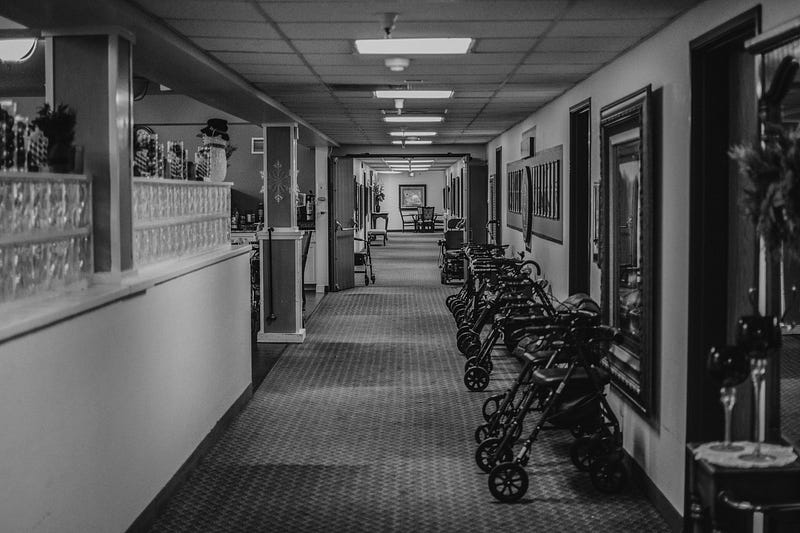When the Tables Turn
A daughter’s experience looking after her aging parents
Story by LEAH ALLEN | Photos by OCTOBER YATES

Roberta Kjesrud, director of writing at the Hacherl Research & Writing Studio at Western Washington University, is no novice when it comes to elder care.
When Roberta was 15, her family moved from a small town in Minnesota to Bellingham to be close to her grandparents. She was on the frontline when her grandma suffered a stroke, making medical decisions in her early 20s while simultaneously helping her grandpa cope. She was there, years later, when grandpa wasn’t eating well. He wouldn’t touch his Meals on Wheels if it contained a single ingredient he detested. She was there when her grandpa moved into independent living, then assisted living and finally a nursing home, where he died of pneumonia at 92 years old.
Being there for her own parents was a whole different story.
When Roberta and her older sister were adults, her parents moved into a sprawling, one-story house with a steep drive. Her dad was a carpenter during his working life and continued to putter around, fixing this, tinkering with that. Neighbors could catch him on the roof well into his 80s. Her mom, Katherine Rude, was a schoolteacher in Minnesota for nearly 15 years.
In her 60s, Katherine developed osteoarthritis and spinal stenosis. Osteoarthritis occurs when the cushy cartilage between joints wears down, resulting in pain, stiffness and swelling. Katherine’s spinal stenosis was caused by calcium deposits in her spinal column. The pressure exerted by the deposits compressed her spine and diminished the ability of certain nerves to function.
She underwent surgery in her late 70s for a cervical spine release, designed to remove some of the calcium deposits. As a result, she was unable to feel her feet. Falling became the norm, but somehow, she managed to dodge injury every time.
“We called her the human Gumby,” Roberta says.
After surgery, Katherine used a Rollator walker around the house; it had four wheels and a built-in seat. She gave up driving voluntarily and relied on her husband to get places. However, he wasn’t always available. So, she sat there.
“She’s always been a homebody, but she was trapped. Literally trapped,” Roberta says.

When Katherine made it clear she was tired of sitting there, Roberta picked out a retirement home. Roberta’s dad didn’t want to move, but he understood it was the right choice for Katherine. The family went on a tour and didn’t leave before Roberta’s parents had signed on the dotted line.
Serge Lindner, section lead of the Center for Senior Health and division chief for primary care at PeaceHealth Medical Group in Bellingham, says assisted living can work well for many people. It can provide meals, friends and activities — all of which may be lacking if someone has become isolated living on their own. Residents may also benefit from help with certain activities of daily living, like medication assistance and house cleaning.
However, assisted living is not for everyone.
“I have a few patients who love it, a few who don’t mind it and quite a few who would rather die than go to [assisted living],” Lindner says.
For patients who want to avoid assisted living altogether, Lindner asks if they have any family members who could move in with them or if they can afford to hire a caregiver.
After moving into the retirement home, Roberta’s mom was still falling regularly and her spine was so fragile that when she did, the fire department had to be called. Roberta became concerned that there was no system in place for checking on her parents, as they lived on a floor only licensed for independent living. If her mom fell, no one would know unless she got her husband’s attention or pulled the alert cord — if she could reach it — to summon help.
As time went on, the number of concerns continued to grow.
When there was a fire in the building, the staff was overwhelmed. Roberta says her mom had to get down four flights of stairs by sliding on her bottom because there weren’t enough people to help her.
To receive additional care, they would have to move to an entirely different floor licensed for assisted living. That would be difficult, partially due to Roberta’s parents’ limited mobility.
Roberta was also concerned about food quality. Her mom said they were served cold meals on more than one occasion.
Roberta says management always gave her the same proactive responses to her complaints, but demonstrated no actual follow-through. She says even after the building’s automatic door knocked her mom on the cement, nothing changed.
“I’ll never get that image out of my mind,” she says.
Two years into her parent’s four-year stay, Roberta helped organize a resident council to bring formal complaints to corporate management. In 2014, the Washington state Department of Social and Health Services inspected the facility and cited them on a number of violations, according to official documents obtained by Klipsun. Five residents were assisted by unapproved caregivers with tasks requiring a nurse. The facility also hired a caregiver who had a disqualifying finding on their background check. That staff member was allowed to work unsupervised with vulnerable adults.

By that time, Roberta had moved her parents into a different retirement home. She says four years was long enough to argue with management and put up with food quality she described as “completely hideous.”
Her dad lived in the second home for about two years, and her mom would have too, if not for a series of health problems.
In August 2016, Roberta’s mom fell, underwent surgery to repair her kneecap and spent time in a nursing home on rehab. Around two weeks after recovering, she developed acute pancreatitis, a painful and potentially deadly inflammation of the pancreas. Following another round of rehab, she returned to assisted living, only to fall for the second time. More surgery. Back to the nursing home. By then, assisted living wouldn’t take her back because she required too much care. She had also used up all her Medicare, so the cost of another nursing home stay before her Medicare reset in 90 days would come out of pocket.
The ordeal lasted eight months. During that time, Roberta would come over everyday after working her full-time job. She came in for the evening shift after her older sister was done with the day shift. Roberta did her mom’s laundry, chased down meals when they didn’t show up, dealt with medications that weren’t delivered on time — the list went on. Over the course of eight months, Roberta took only three days off from caring for her mom.
On top of it all, her dad’s health was also tanking.
For children caring for their aging parents, the lines between their life and the lives of their parents often get blurred.
Roberta is designated as her parents’ agent on their financial power of attorney document. Part of that role includes buying them everything they need.
“You’ll get a call like, ‘I’m out of X and I need it now,’” Roberta says. “How do you respond to that? Do you drop everything and go get that and bring it?”
Not always. To set limits, Roberta had to learn to say no in some cases.
Roberta also meets with her parents’ money manager, tracks all their expenses, does their taxes, balances their books, decides when they need more money in the bank and when to sell their assets.

Her sister is the appointed agent for the health care power of attorney. Some of her responsibilities include making doctor appointments, accompanying her parents and taking notes during the appointments, scheduling follow-ups and handling referrals.
The two make decisions together, but the different roles are a way of dividing some of the labor.
Roberta’s parents now live in their third retirement home.
Katherine sits in her apartment surrounded by colorful wooden birds. Her children and their husbands placed the ones in spots she couldn’t reach from her wheelchair. A birthday balloon hovers above a table. She turned 90 on Nov. 6.
Each day, her husband comes over from his own apartment three doors down. They sit together in her small living room and talk, then make their way to the dining room for supper.
They both wanted a two-bedroom apartment, but none were available upon move in. Separate bedrooms work better because the two have uncoordinated needs and different sleep schedules.
Before the days of senior residences, Katherine and her husband were active members of their church. Even after they stopped being able to attend services, their pastor would visit them and letters would arrive from church friends telling them they were missed. Now that the two are in a retirement home, Katherine says those ties have weakened.
She has to work harder in order to stay busy. If she’s not coloring, painting or fiddling with things in the hallway, she’s likely lost in a book. Or she’s grumbling in frustration because housekeeping put things away in all the wrong places or didn’t dust her apartment properly.
Relying on others isn’t easy.
“You are a person. You know you’re a person. But you’re treated like a lump of nothing,” she says.
After years of receiving care, Katherine knows what she wants.
She wants hot food to stay hot, alert buzzers in reach, non-slip shower floors, non-carpeted apartment floors, plenty of activities, ample help when needed and cheerful caregivers who will respect and listen to her.
When I met Katherine, the first thing I asked her was to tell me about herself.
“I’m a little old curmudgeonly woman who speaks her mind.”
Roberta’s dad passed away on Nov. 19, 2017.
